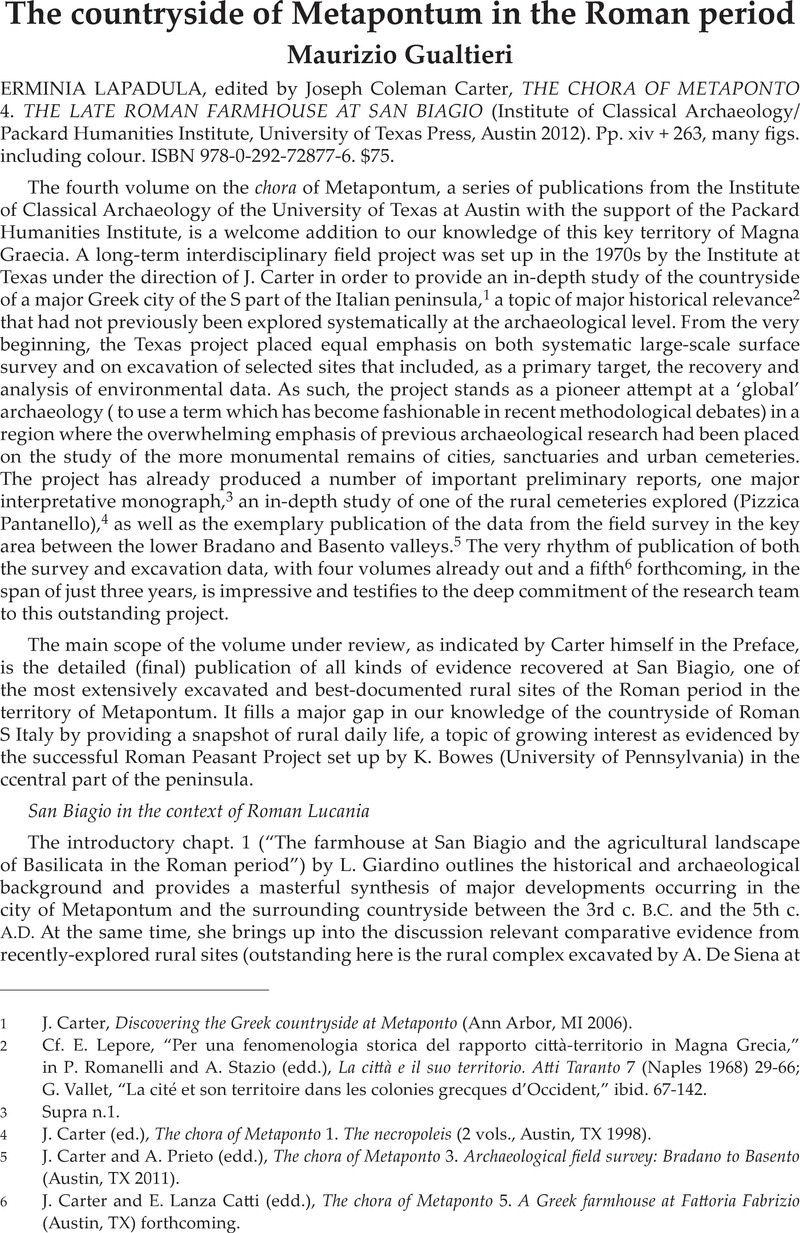No CrossRef data available.
Published online by Cambridge University Press: 27 November 2014

1 Carter, J., Discovering the Greek countryside at Metaponto (Ann Arbor, MI 2006)CrossRefGoogle Scholar.
2 Cf. Lepore, E., “Per una fenomenologia storica del rapporto città-territorio in Magna Grecia,” in Romanelli, P. and Stazio, A. (edd.), La città e il suo territorio. Atti Taranto 7 (Naples 1968) 29–66 Google Scholar; G. Vallet, “La cité et son territoire dans les colonies grecques d’Occident,” ibid. 67-142.
3 Supra n.1.
4 Carter, J. (ed.), The chora of Metaponto 1. The necropoleis (2 vols., Austin, TX 1998)Google Scholar.
5 Carter, J. and Prieto, A. (edd.), The chora of Metaponto 3. Archaeological field survey: Bradano to Basento (Austin, TX 2011)Google Scholar.
6 Carter, J. and Catti, E. Lanza (edd.), The chora of Metaponto 5. A Greek farmhouse at Fattoria Fabrizio (Austin, TX) forthcomingGoogle Scholar.
7 De Siena, A., “La documentazione archeologica nei territori delle colonie greche di Metaponto e Herakleia,” in Atti Taranto 44 (Taranto 2005) 407–63Google Scholar.
8 The date of the 3rd c. A.D. indicated on the plan of the site (fig. 1.3) is obviously an error, as well as the quote from M. Torelli (4 n.16), which undoubtedly refers to the transformations of the rural landscape in inland Lucania during the 3rd c. B.C. (not A.D.).
9 Supra n.5.
10 See 221 and n.52 in the volume under review, and the emblematic formulation of the conventional view in Russi, A., “La romanizzazione, il quadro storico: età repubblicana e imperiale,” in Adamesteanu, D. (ed.), Storia della Basilicata I. L’Antichità (Bari 1999) 487–554 Google Scholar.
11 Cascio, E. Lo and Marino, A. Storchi (edd.), Modalità insediative e strutture agrarie nell’Italia meridionale in età romana (Bari 2001) 5–12 Google Scholar; Gualtieri, M. (ed.), La Lucania romana. Cultura e società nella documentazione archeologica (Quaderni di Ostraka 8; Naples 2003) 37–39 Google Scholar.
12 Carter (supra n.1) 252; Launaro, A., Peasants and slaves: the rural population of Roman Italy (200 BC–AD 100) (Cambridge 2011)Google Scholar.
13 Crawford, M., “Brave new world: Metapontum after Metapontum,” in Cébeillac-Gervasoni, M. and Lamoine, L. (edd.), Les élites et leurs facettes (CollEFR 309, 2003)Google Scholar, quotation on 20.
14 T. J. Cornell, “ Hannibal’s legacy: the effects of the Hannibalic War on Italy,” in id. et al. (edd.), The Second Punic war. A reappraisal (BullInstClassStudLon Suppl. 67, 1996) 97-117.
15 E. Lapadula, “Imperial and Late Roman settlement in the Metapontino,” in Carter and Prieto (supra n.5) 1138-45, fig. 32.3.
16 L. Giardino, “La fascia ionica della Basilicata in età tardo antica. Continuità e trasformazioni,” Stazio, A. and Carratelli, G. Pugliese (edd.), L'Italia meridionale in età tardo antica. Atti Taranto (Taranto 1999) 357–59Google Scholar.
17 Stazio and Pugliese Carratelli ibid.
18 Carter (supra n.1) 250-51.
19 Aprosio, M., Archeologia dei paesaggi a Brindisi dalla romanizzazione al Medioevo (Bari 2008)Google Scholar.
20 Goffredo, R., Aufidus. Storia, archeologia e paesaggi della Valle dell'Ofanto (Bari 2011) 67–72 Google Scholar, with review by Colivicchi, F. in JRA 25 (2012) 586–92Google Scholar.
21 Mangiatordi, A., Insediamenti rurali e strutture agrarie nella Puglia centrale in età romana (Bari 2011) 99–108 Google Scholar, with review by Small, A. in JRA 26 (2013) 748–49Google Scholar.
22 Vera, D., “I paesaggi rurali del Meridione tardoantico: bilancio consuntivo e preventivo,” in Volpe, G. and Turchiano, M. (edd.), Paesaggi e insediamenti rurali in Italia meridionale fra tardoantico e altomedioevo. Atti 1 seminario 2004 (Bari 2005) 23–38 Google Scholar.
23 Lapadula (supra n.15) 1142.
24 Madsen, J., “Signs of prosperity in Roman villas in South Italy during the third century,” AnalRom 29 (2002) 29–53 Google Scholar.